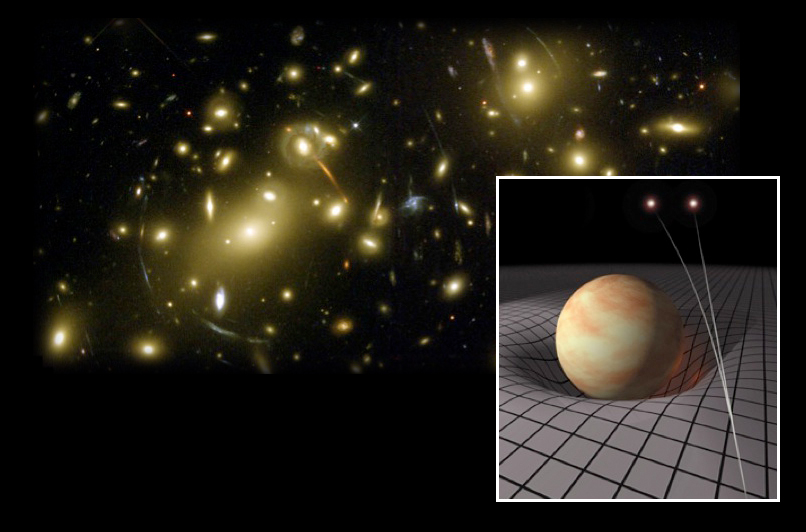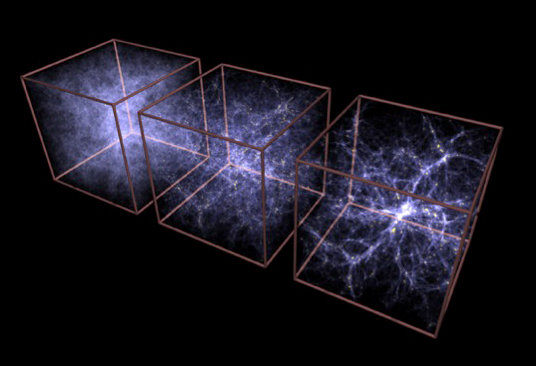Contact: Paul Preuss

Mass can act like a lens: a mass like that of a star or giant planet can displace the apparent position of distant stars. Very massive objects like clumps of dark matter can be strong gravitational lenses. Weak lensing is less obvious but just as useful in “weighing” invisible dark matter. (Strong gravitational lens in Abell 2218 by Hubble Space Telescope; inset from Sean Carroll, “Spacetime and Geometry: An Introduction to General Relativity”)
“Einstein’s theory of General Relativity is how we understand gravity,” says Martin White, “and it’s never a good idea to bet against Einstein.” Nevertheless, astronomers know a good way to test whether there’s a breakdown in General Relativity.
Gravitational lensing arises directly from Einstein’s realization that what we call gravity is the fact that mass curves the space-time fabric of the Universe. If there is a chunk of matter between us and a distant object – say, our Sun between us and a distant star – then the intervening mass of the Sun acts as a lens, bending space so as to enlarge and outwardly displace the distant star’s apparent position. In fact it was the displacement of stars during a solar eclipse, measured by Sir Arthur Eddington in 1919, that provided the first experimental evidence for Einstein’s revolutionary theory.
Obvious visible displacement is characteristic of a phenomenon known as strong gravitational lensing. Weak lensing is less obvious, but still measurable, as a statistical estimate of the distortion of the apparent size and shape (shear) of background galaxies behind an intervening mass – which may be a single galaxy, a cluster of galaxies, or a concentration of invisible dark matter.
“Because weak lensing can trace the evolution of all the matter in the Universe, visible and dark, a lot of people have been excited about using it to measure dark energy since at least the 1990s,” says Uroš Seljak, a member of Berkeley Lab’s Physics Division and a professor of astronomy and physics at UC Berkeley. “The problem is that for a long time it was difficult to implement on telescopes. It’s a subtle effect, and all sorts of distortions – in the atmosphere, the cameras, or the telescopes themselves – can interfere with good measurements.”
Weak lensing directly detects matter, including dark matter, but it can also be used to study dark energy, says Seljak, “because dark energy will affect how matter grows in time.”
In fact, says Seljak, “dark energy slows the growth of structure.” This is because structure results from the mutual gravitational attraction of matter; dense regions progressively grow more dense. But dark energy is “a sea of smooth energy” that uniformly expands space and everywhere acts against increasing density.
Seljak describes two ways that weak lensing can be measured. One, called “shear-shear” correlations, measures the combined effects of all the matter between us and the distant galaxies being observed – not the effect of any particular structure alone. “The farther away the galaxies we’re looking at are, the earlier in the history of the Universe we can observe,” he says. Effects of weak lensing have been detected at great distances, and there are even hints of weak lensing in the cosmic microwave background itself.
A different technique, for which Seljak uses the shorthand “galaxy-shear,” looks at weak lensing around galaxies or clusters of galaxies. This method is much less sensitive to spurious distortions than the cumulative shear-shear method, because with this technique many of the spurious distortions are self-canceling.

Using weak lensing to deduce the large scale structure of the Universe at various epochs, researchers can measure the effects of dark energy on the growth of structure, a direct measurement of whether General Relativity gives the correct description of gravity.
The two techniques are complementary; both require enormous databases, powerful computers, and programs that can derive the mass signature from the shear signal and find the constraints thus imposed on possible cosmologies, so that the results can be compared to the predicted effects of different theories of dark energy. Among the Berkeley Lab cosmologists who are investigating applications of weak lensing are Alexie Leauthaud and Reiko Nakajima of the Physics Division.
“Weak lensing is a powerful method for measuring the growth of structure over time,” says White. “General Relativity makes a unique prediction about the growth of structures. At a particular expansion rate, did structures grow according to Einstein? If Relativity is wrong, we’ll see it directly.”
More to come
Supernovae, baryon acoustic oscillations, and weak lensing are not the only techniques proposed for studying dark energy, although at present they are the most mature. So far, Type Ia supernovae have been the most used for measuring the expansion history of the Universe.
In addition to the Joint Dark Energy Mission satellite, which will apply all three methods, Berkeley Lab is participating in a number of other dark energy missions such as the multi-agency, multi-institutional, multinational Dark Energy Survey, in which a special red-sensitive camera will be mounted on a four-meter telescope in Chile with the stated goal of answering the question, “is the dark energy a cosmological constant?”
As in the beginning, the cosmological constant remains the favorite form of dark energy among many – although far from all – astronomers, astrophysicists, and cosmologists. But answering the question – cosmological constant or something else? – will be only the beginning of investigation into the nature of the biggest mystery in 21st-century physics.
Additional information
Weak lensing and other projects in cosmology are described by Uroš Seljak at http://www.physics.berkeley.edu/research/faculty/seljak.html
For more on weak lensing, watch Alexie Leauthaud and Reiko Nakajima’s Summer Lecture on “What is Gravitational Lensing” at http://www.youtube.com/berkeleylab#p/search/0/vIHDsrVECfE.
The Evolving Search for the Nature of Dark Energy, part 1 – supernovae
The Evolving Search for the Nature of Dark Energy, part 2 – baryon acoustic oscillation